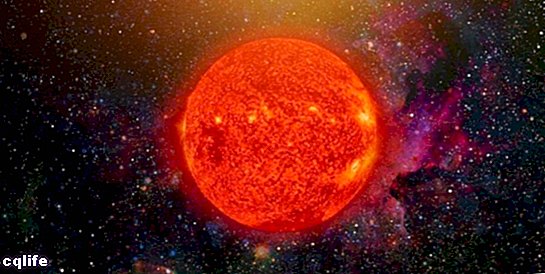- What is the Sun?
- Structure and parts of the Sun
- Sun temperature
- Importance of the Sun for life
- Solar system
We explain everything about the Sun, the parts that compose it, its temperature and other characteristics. Also, the Solar System.

What is the Sun?
The Sun is the closest star to the planet Earth, located 149.6 million kilometers away. All the planets of the Solar system they orbit around it at different distances, attracted by its gigantic gravity, as well as the kites Y asteroids that we know. The Sun is commonly known by the name of King Star.
It is a star quite common of our galaxy, the Milky Way: it is neither too big nor too small compared to its millions of sisters. Scientifically, the Sun is classified as a yellow dwarf star, of the G2 type.
It is currently in its main sequence of life. It is located in a region outside of the galaxy, in one of its spiral arms, 26,000 light years from the galactic center.
However, the size of the Sun is such that it represents 99% of the entire mass of the Solar System, equivalent to about 743 times that of mass total of each and every one planets combined, and about 330,000 times the mass of our planet.
Its diameter is 1.4 million kilometers, making it the largest and brightest object in the Earth's sky. That is why their presence makes the difference between day and night.
For the rest, the Sun is a huge ball of plasma, almost round. It is composed mostly of hydrogen (74.9%) and helium (23.8%), as well as a small portion (2%) of heavier elements such as oxygen, carbon, neon, and iron.
Hydrogen is the Sun's main fuel. However, due to combustion it is converted into helium, leaving behind a layer of helium “ashes” as the star progresses through its main life cycle.
Structure and parts of the Sun
Each layer of the Sun has its own temperature and characteristics.The Sun is a spherical star, with a slight flattening at its poles, the result of its movement rotation. Despite being a gigantic and continuous atomic bomb fusion of atoms hydrogen, the huge force of gravity that its mass gives it compensates for the thrust of the internal explosion, thus reaching a balance that allows its existence to continue.
The Sun is structured in layers, more or less like an onion. These layers are:
- The nucleus. The innermost region of the Sun, which occupies a fifth of the total of the star: about 139,000 kilometers of its total radius. It is there where the gigantic atomic explosion of hydrogen merging takes place; but such is the gravity that is in the solar nucleus, that at the Energy produced in this way it takes about a million years for it to emerge to the surface.
- The radiant zone.It is composed of plasma, that is, of ionized gases such as helium and / or hydrogen, and it is the region that allows the easiest radiation of energy to the outer layers, which considerably reduces the temperature that is registered in this place.
- The convective zone. It is a region where gases they are no longer ionized, making it more difficult for energy (in the form of photons) to escape out of the Sun. This causes the energy to escape only by heat convection, much more slowly. Thus, the solar fluid heats up unevenly, causing dilations, losses of density and rising or falling currents, like an inland tide.
- The photosphere. The region of the Sun where the light visible, which is perceived as shiny granules on a darker surface, although it is a transparent layer about 100 to 200 km deep. It is considered the surface of the star, and it is where sun spots appear.
- The chromosphere. This is the name given to the outer layer of the photosphere itself, much more translucent still and difficult to appreciate, since it is opaque by the brightness of the previous layer. It has a size of around 10,000 km and seen during an eclipse, it has an external reddish hue.
- The solar corona. The fainter layers of the atmosphere external layer of the Sun, in which the temperature increases considerably with respect to the inner layers. This is a mystery of the solar nature. However, there are low densities of matter next to intense magnetic fields, traversed by energy and matter at very high speeds, as well as by numerous X-rays.
Sun temperature
As we have seen, the temperature of the Sun varies according to the region of the star, although by our standards it is, in all, incredibly high.
Temperatures close to 1.36 x 106 degrees Kelvin (that is, about 15 million degrees Celsius) can be recorded in the solar core, while on the surface the temperature drops to “barely” 5,778 K (around 5,505 ° C). , and ascends again in the solar corona at 2 x 105 degrees Kelvin.
Importance of the Sun for life

Due to its continuous emission of electromagnetic radiation, including the light perceptible by our eyes, the Sun provides heat and illumination to our planet, making life possible as we know it. For this reason, the Sun is irreplaceable.
Its light allows photosynthesis, without which the atmosphere would not contain the levels of oxygen that we need, nor the plant life to sustain the different Trophic chains. On the other hand, his heat keep the weather stable, allows the existence of Water liquid and gives energy to the different climatic cycles.
Lastly, solar gravity keeps planets orbiting around it, including Earth. Without it there would be no day and night, there would be no seasons, and Earth would surely be a cold, dead planet, as are many of the outer planets.
This is reflected in human culture: the Sun usually occupies a central place in the religious imagination, as a fertilizing father god, throughout almost all known mythologies. All the great gods, kings or messiahs have been in one way or another associated with its brilliance, while the death, the nothingness and the evil or secret arts are associated with the night and the nocturnal.
Solar system
Planets and other objects in the Solar System orbit the Sun.We thus call the planetary "neighborhood" where the Earth is located, that is, the circuit of eight planets that they orbit constantly the Sun. This neighborhood is part of the Local Interstellar Cloud, part of the Local Bubble of the arm of Orion. It is estimated that it arose 4.568 million years ago, as a consequence of the collapse of a molecular cloud.
It consists of the following objects:
- The Sun, the only star located at its center.
- The inner, smaller, and warmer planets: Mercury, Venus, Earth, and Mars. Next to them, their respective moons or satellites.
- The outer planets, gigantic balls of icy gas: Saturn, Jupiter, Neptune and Uranus. Next to them, their respective moons or satellites.
- The dwarf planets, such as Pluto, Ceres or Pallas.
- The asteroid belt that separates the inner planets from the outer ones.
- The Kuiper Belt and the Oort Cloud, two sets of trans-Neptunian objects from which comets come.
